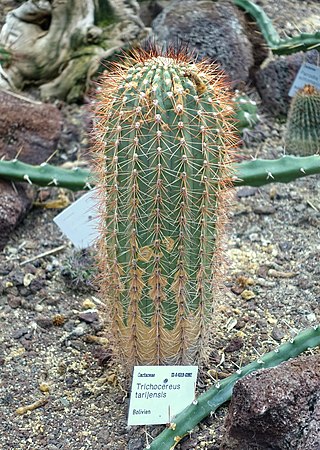
Escontria is a genus of cactus. The only species is Escontria chiotilla, the chiotilla or jiotilla.

Brasiliopuntia is a genus in the cactus family, Cactaceae. It contains only one species, Brasiliopuntia brasiliensis.

Cleistocactus hyalacanthus is a species of columnar cacti in the genus Cleistocactus. The name comes from the Greek kleistos meaning closed because the flowers hardly open.

Harrisia pomanensis is a species of cactus.

Soehrensia thelegona is a species of cactus in the Soehrensia genus.

Cereus aethiops is a species of cactus found from Uruguay to Argentina.

Praecereus euchlorus is a flowering plant in the family Cactaceae that is found in Brazil, Bolivia and Paraguay at elevations of 700 to 1300 meters

Praecereus saxicola is a flowering plant in the family Cactaceae that is found in Bolivia, Argentina and Paraguay

Gymnocalycium spegazzinii is a species of Gymnocalycium from Argentina and Bolivia named after the botanist C. L. Spegazzini.

Lobivia ancistrophora is a species of cactus. It has a globular shape, few spines, with large, white flowers attached to long, green tubes. It occurs in Bolivia, at altitudes of 600–1800 metres. Under its synonym Echinopsis ancistrophora it has gained the Royal Horticultural Society's Award of Garden Merit.

Cereus phatnospermus, synonym Cereus kroenleinii, is a species of columnar cactus found in Brazil, Bolivia, and Paraguay.

Cereus vargasianus is a species of columnar cactus found in Peru.

Soehrensia tarijensis, is a species of Soehrensia, in the cactus family. It is native to Bolivia and northwestern Argentina.

Acanthocalycium rhodotrichum is a species of Acanthocalycium found in Argentina, Bolivia, Brazil, Paraguay, and Uruguay.

Xiquexique gounellei is a species of plant in the genus Xiquexique of the cactus family. Common names include "Alastrado", "Chique-Chique", "Xique-Xique" and "Xique-Xique das Pedras".

Cleistocactus laniceps is a species of columnar cacti in the genus Cleistocactus.

Cleistocactus parviflorus is a species of columnar cacti in the genus Cleistocactus.

Cephalocereus fulviceps is a species of Cephalocereus from Mexico.

Cephalocereus columna-trajani is a species of cactus from Mexico.

Echinocereus brandegeei is a species of cactus native to Mexico.






















